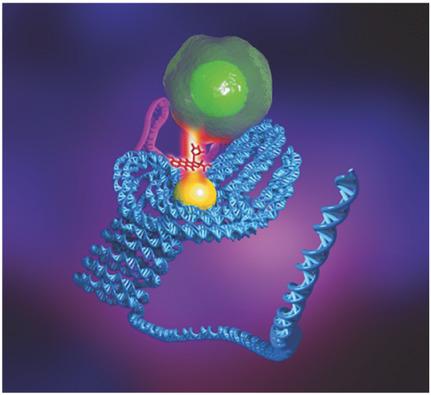当前位置:
X-MOL 学术
›
Adv. Mater.
›
论文详情
Our official English website, www.x-mol.net, welcomes your
feedback! (Note: you will need to create a separate account there.)
Programmable and Multifunctional DNA‐Based Materials for Biomedical Applications
Advanced Materials ( IF 27.4 ) Pub Date : 2018-02-01 , DOI: 10.1002/adma.201703658 Yuezhou Zhang 1 , Jing Tu 1 , Dongqing Wang 2 , Haitao Zhu 2 , Sajal Kumar Maity 3 , Xiangmeng Qu 4 , Bram Bogaert 1 , Hao Pei 4 , Hongbo Zhang 1, 2, 5
Advanced Materials ( IF 27.4 ) Pub Date : 2018-02-01 , DOI: 10.1002/adma.201703658 Yuezhou Zhang 1 , Jing Tu 1 , Dongqing Wang 2 , Haitao Zhu 2 , Sajal Kumar Maity 3 , Xiangmeng Qu 4 , Bram Bogaert 1 , Hao Pei 4 , Hongbo Zhang 1, 2, 5
Affiliation

|
DNA encodes the genetic information; recently, it has also become a key player in material science. Given the specific Watson–Crick base‐pairing interactions between only four types of nucleotides, well‐designed DNA self‐assembly can be programmable and predictable. Stem‐loops, sticky ends, Holliday junctions, DNA tiles, and lattices are typical motifs for forming DNA‐based structures. The oligonucleotides experience thermal annealing in a near‐neutral buffer containing a divalent cation (usually Mg2+) to produce a variety of DNA nanostructures. These structures not only show beautiful landscape, but can also be endowed with multifaceted functionalities. This Review begins with the fundamental characterization and evolutionary trajectory of DNA‐based artificial structures, but concentrates on their biomedical applications. The coverage spans from controlled drug delivery to high therapeutic profile and accurate diagnosis. A variety of DNA‐based materials, including aptamers, hydrogels, origamis, and tetrahedrons, are widely utilized in different biomedical fields. In addition, to achieve better performance and functionality, material hybridization is widely witnessed, and DNA nanostructure modification is also discussed. Although there are impressive advances and high expectations, the development of DNA‐based structures/technologies is still hindered by several commonly recognized challenges, such as nuclease instability, lack of pharmacokinetics data, and relatively high synthesis cost.
中文翻译:

生物医学应用中基于可编程和多功能DNA的材料
DNA编码遗传信息。最近,它也已成为材料科学的关键角色。鉴于只有四种类型的核苷酸之间存在特定的Watson-Crick碱基配对相互作用,精心设计的DNA自组装可以是可编程且可预测的。茎环,粘性末端,霍利迪结,DNA瓦片和格子是形成基于DNA的结构的典型图案。寡核苷酸在含有二价阳离子(通常为Mg 2+)以产生各种DNA纳米结构。这些结构不仅显示出美丽的风景,而且还具有多方面的功能。这篇综述从基于DNA的人工结构的基本特征和进化轨迹开始,但重点在于它们的生物医学应用。涵盖范围从药物控制到高治疗水平和准确的诊断。各种基于DNA的材料,包括适体,水凝胶,牛至和四面体,已广泛用于不同的生物医学领域。此外,为了获得更好的性能和功能,材料杂交得到了广泛的认可,并且还讨论了DNA纳米结构的修饰。尽管取得了令人瞩目的进步和很高的期望,
更新日期:2018-02-01
中文翻译:

生物医学应用中基于可编程和多功能DNA的材料
DNA编码遗传信息。最近,它也已成为材料科学的关键角色。鉴于只有四种类型的核苷酸之间存在特定的Watson-Crick碱基配对相互作用,精心设计的DNA自组装可以是可编程且可预测的。茎环,粘性末端,霍利迪结,DNA瓦片和格子是形成基于DNA的结构的典型图案。寡核苷酸在含有二价阳离子(通常为Mg 2+)以产生各种DNA纳米结构。这些结构不仅显示出美丽的风景,而且还具有多方面的功能。这篇综述从基于DNA的人工结构的基本特征和进化轨迹开始,但重点在于它们的生物医学应用。涵盖范围从药物控制到高治疗水平和准确的诊断。各种基于DNA的材料,包括适体,水凝胶,牛至和四面体,已广泛用于不同的生物医学领域。此外,为了获得更好的性能和功能,材料杂交得到了广泛的认可,并且还讨论了DNA纳米结构的修饰。尽管取得了令人瞩目的进步和很高的期望,











































 京公网安备 11010802027423号
京公网安备 11010802027423号